In a first, ECI holds ‘Conference on Low Voter Turnout’ with Municipal Commissioners and DEOs from select districts to increase voter turnout in 2024 Lok Sabha Elections
In a first, ECI holds ‘Conference on Low Voter Turnout’ with Municipal Commissioners and DEOs from select districts to increase voter turnout in 2024 Lok Sabha Elections
Ahead of the polling in the ongoing General Elections 2024, Election Commission of India (ECI) has accelerated efforts to enhance voter turnout in Parliamentary Constituencies (PCs) with a history of low poll participation in previous General Elections. In a day long ‘Conference on Low Voter Turnout’ held today at Nirvachan Sadan, New Delhi, Municipal Commissioners from major cities and select District Election Officers (DEOs) from Bihar and Uttar Pradesh deliberated together to chart a path towards enhancing voter engagement and participation in identified urban and rural PCs. The Conference was chaired by Chief Election Commissioner Shri Rajiv Kumar along with Election Commissioners Shri Gyanesh Kumar and Shri Sukhbir Singh Sandhu. On the occasion, a booklet on voter apathy was released by the Commission.
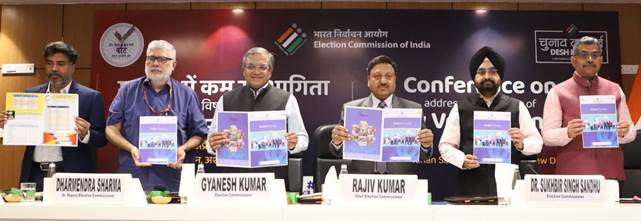
11 States/UTs namely Bihar, Uttar Pradesh, NCT of Delhi, Maharashtra, Uttarakhand, Telangana, Gujarat, Punjab, Rajasthan, J&K and Jharkhand had a voter turnout lower than the national average of 67.40% in the 2019 General Elections to the Lok Sabha. Out of the total 50 Rural PCs across 11 states identified with lower voter turnout than the national average in 2019, 40 PCs are from Uttar Pradesh (22 PCs) and Bihar (18PCs). In UP, 51- Phulpur PC recorded the lowest turnout of 48.7%, while in Bihar, 29-Nalanda PC recorded lowest turnout of 48.79%.
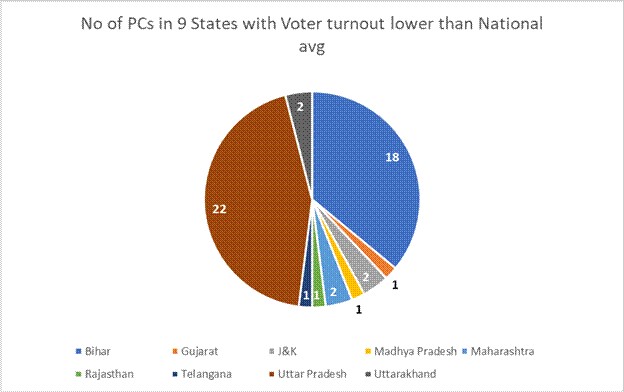
While addressing the Municipal Commissioners and DEOs, CEC Shri Rajiv Kumar said that a total of 266 Parliamentary Constituencies (215 Rural & 51 Urban) with low voter turnout have been identified and all concerned Municipal Commissioners, DEOs and State CEOs have been called today to find ways to reach out to voters in targeted manner. He emphasized on a three pronged strategy of providing facilitation at polling stations like queue management, shelter parking in congested areas; targeted outreach & communication; and involvement of critical stakeholders like RWAs, local icons and youth influencers to persuade people to come to polling stations.
CEC Kumar directed them to prepare a booth wise action plan for enhanced participation and behaviour change. He asked all MCs and DEOs to prepare different strategies for urban and rural areas and plan interventions accordingly for different target audiences. He emphasized that the “One size fits all” approach will not yield results. CEC Kumar also urged the authorities to act in a manner that instils pride among the voters in participating in the democratic festivities. He called for a movement in which people are self-motivated to vote.
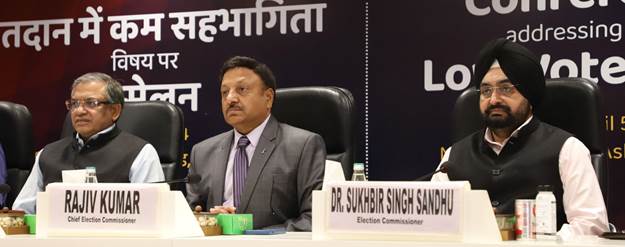
The conference, a collaborative effort between the ECI and key stakeholders, focused on crafting a comprehensive action plan to address voter apathy, streamline logistical operations, and increase voter turnout. Discussions were centred on critical issues such as optimizing queue management at polling stations, facilitating voting in high-rise buildings, and leveraging the influential Systematic Voters’ Education and Electoral Participation (SVEEP) programme.
With a keen emphasis on partnership and inclusivity, the ECI urged Municipal Commissioners and DEOs to actively contribute to the initiative. Urban specific hurdles to increased voter turnout were identified and targeted city specific interventions were planned and the officers were encouraged to develop tailored, region-specific outreach programs that resonate with the unique needs and demographics of their constituencies. In line with this vision, the ECI outlined an array of innovative voter awareness campaigns under SVEEP, including:
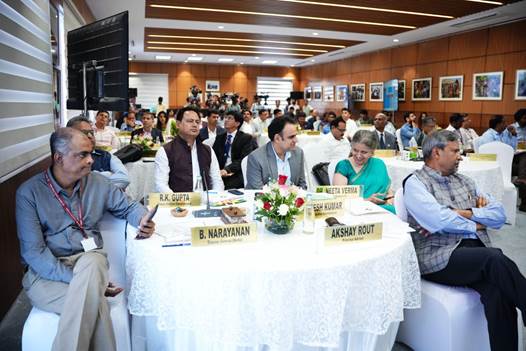
The Conference was attended by Municipal Commissioners of Delhi, Mumbai, Chennai, Bengaluru, Hyderabad, Ahmedabad, Pune, Thane, Nagpur, Patna Sahib, Lucknow and Kanpur as well as select District Election Officers of Bihar and Uttar Pradesh. CEO Bihar, CEO Uttar Pradesh, CEO Maharashtra and CEO Delhi also attended the conference with CEOs of 7 states namely Karnataka, Gujarat, Madhya Pradesh, Rajasthan, Tamil Nadu, Telangana and Punjab joined virtually.
Background:
Approximately 297 million eligible voters did not vote in the General Elections to Lok Sabha in 2019 underscoring the scale of the problem which calls for proactive measures. Furthermore, recent elections across various states have highlighted trends of urban apathy towards the electoral process, warranting targeted interventions and collaborative endeavours.
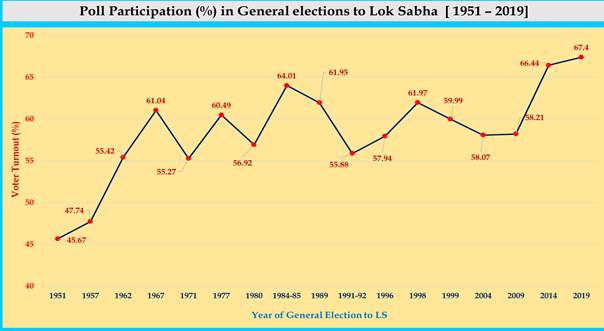
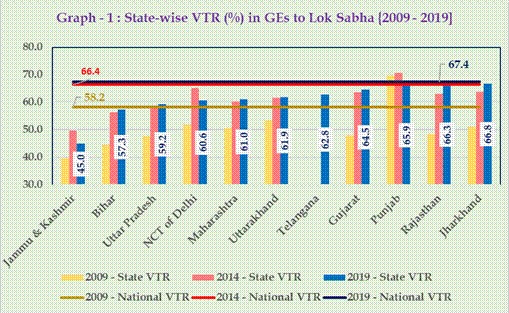

Of the 50 PCs with the lowest voter turnout in the 2019 GE to Lok Sabha, 17 were found to be in Metropolitans or major cities reflecting an unfortunate trend of urban apathy. The same trend has been seen in the past few State Assembly Elections. In General Gujarat State Legislative Assembly elections 2022, Gandhidham AC in Kachchh district, which has industrial establishments, recorded lowest polling percentage of 48.14%, a sharp decline of almost 6% than the last election in 2017, recording a new low. Similarly, in GE to SLA of Himachal Pradesh 2022, the Shimla AC in Shimla District (State Capital) recorded the lowest polling percentage of 63.48% against the State Average Poll % of 75.78%. It has been observed that all rural Assembly Constituencies have voted more in percentage terms than urban Assembly Constituencies of Surat. The difference in lowest urban AC of Surat with highest rural AC is as much as 25%. Similarly, in the State Legislative Assembly Election of Karnataka 2023, AC Bommanahalli in Bangalore (Bangalore South) recorded the lowest VTR of 47.5% as compared to State Average VTR of 73.84%.
List of 50 PCs with lowest VTR in General Election to Lok Sabha – 2019
Sr. No.
State Name
PC NO.
PC NAME
PC VTR (%)
State VTR (%)
1
Jammu & Kashmir
3
Anantnag
8.98
44.97
2
Jammu & Kashmir
2
Srinagar
14.43
44.97
3
Jammu & Kashmir
1
Baramulla
34.60
44.97
4
Telangana
9
Hyderabad
44.84
62.77
5
Maharashtra
24
Kalyan
45.31
61.02
6
Bihar
30
Patna Sahib
45.80
57.33
7
Telangana
8
Secundrabad
46.50
62.77
8
Uttar Pradesh
51
Phulpur
48.70
59.21
9
Bihar
29
Nalanda
48.79
57.33
10
Bihar
35
Karakat
49.09
57.33
11
Maharashtra
25
Thane
49.39
61.02
12
Telangana
7
Malkajgiri
49.63
62.77
13
Bihar
39
Nawada
49.73
57.33
14
Maharashtra
34
Pune
49.89
61.02
15
Maharashtra
31
Mumbai South
51.59
61.02
16
Uttar Pradesh
43
Kanpur
51.65
59.21
17
Bihar
36
Jahanabad
51.76
57.33
18
Bihar
32
Arrah
51.81
57.33
19
Uttar Pradesh
52
Allahabad
51.83
59.21
20
Uttar Pradesh
58
Shrawasti
52.08
59.21
21
Uttar Pradesh
59
Gonda
52.20
59.21
22
Uttar Pradesh
60
Domariyaganj
52.26
59.21
23
Uttarakhand
3
Almora
52.31
61.88
24
Maharashtra
23
Bhiwandi
53.20
61.02
25
Telangana
10
CHEVELLA
53.25
62.77
26
Uttar Pradesh
78
Bhadohi
53.53
59.21
27
Uttar Pradesh
39
Pratapgarh
53.56
59.21
28
Bihar
37
Aurangabad
53.67
57.33
29
Maharashtra
29
Mumbai North central
53.68
61.02
30
Karnataka
26
Bangalore South
53.70
68.81
31
Bihar
6
Madhubani
53.81
57.33
32
Bihar
19
Maharajganj
53.82
57.33
33
Bihar
33
Buxar
53.95
57.33
34
Uttar Pradesh
37
Amethi
54.08
59.21
35
Uttar Pradesh
62
Sant Kabir Nagar
54.20
59.21
36
Karnataka
25
Bangalore central
54.32
68.81
37
Uttar Pradesh
72
Ballia
54.35
59.21
38
Maharashtra
27
Mumbai North West
54.37
61.02
39
Uttar Pradesh
57
Kaiserganj
54.39
59.21
40
Madhya Pradesh
2
BHIND
54.53
71.20
41
Uttar Pradesh
50
Kaushambi
54.56
59.21
42
Bihar
34
Sasaram (SC)
54.57
57.33
43
Bihar
18
Siwan
54.73
57.33
44
Karnataka
24
Bangalore North
54.76
68.81
45
Uttar Pradesh
35
Lucknow
54.78
59.21
46
Uttar Pradesh
68
Lalganj
54.86
59.21
47
Bihar
28
Munger
54.90
57.33
48
Maharashtra
10
Nagpur
54.94
61.02
49
Uttarakhand
2
Garhwal
55.17
61.88
50
Rajasthan
10
KARAULI-DHOLPUR
55.18
66.34
Note: PCs corresponding to rows with coloured background are identified as PCs of Metro or Major Cities.
In response to these challenges, the ECI has implemented a suite of initiatives aimed at reinvigorating voter engagement and participation, including:
The Election Commission of India is committed to foster a vibrant democracy by actively engaging citizens and removing barriers to voter participation.